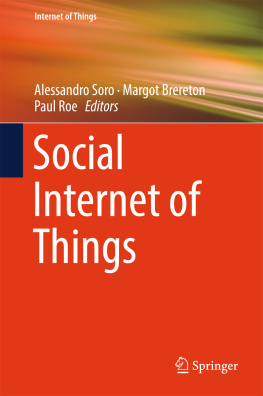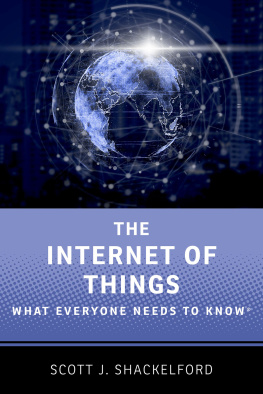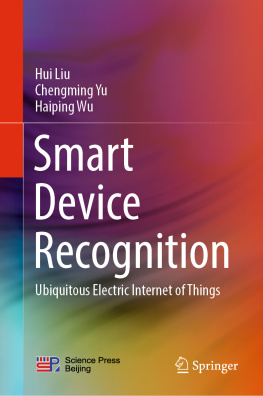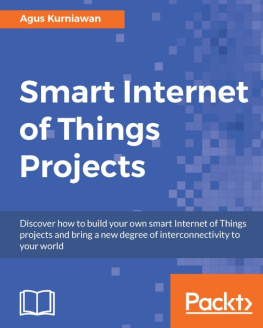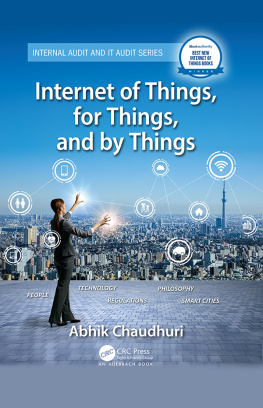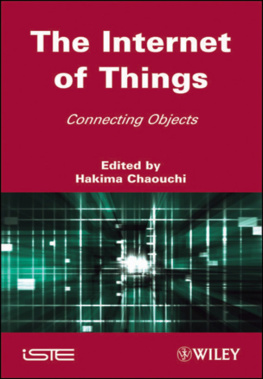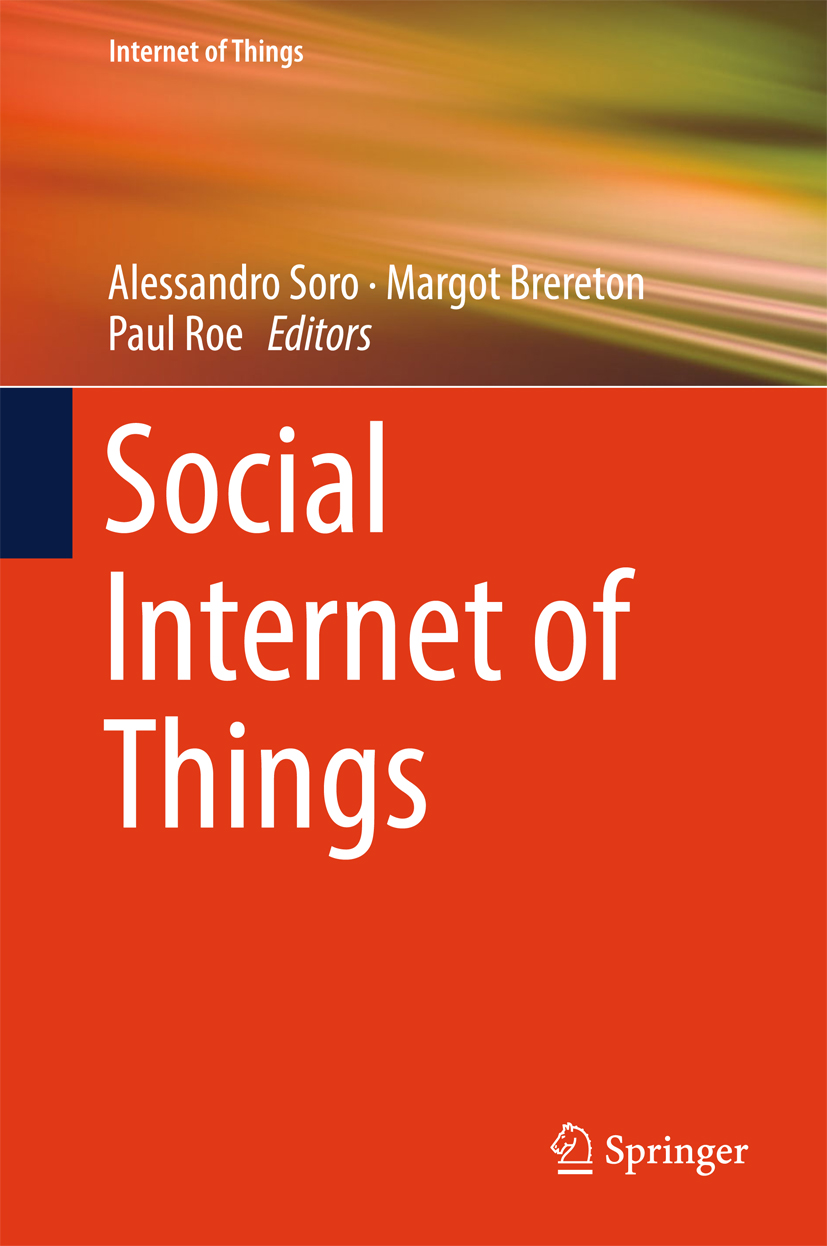Editors
Alessandro Soro
Queensland University of Technology (QUT), Brisbane, QLD, Australia
Margot Brereton
Queensland University of Technology (QUT), Brisbane, QLD, Australia
Paul Roe
Queensland University of Technology (QUT), Brisbane, QLD, Australia
ISSN 2199-1073 e-ISSN 2199-1081
Internet of Things
ISBN 978-3-319-94657-3 e-ISBN 978-3-319-94659-7
https://doi.org/10.1007/978-3-319-94659-7
Library of Congress Control Number: 2018945462
Springer Nature Switzerland AG 2019
This work is subject to copyright. All rights are reserved by the Publisher, whether the whole or part of the material is concerned, specifically the rights of translation, reprinting, reuse of illustrations, recitation, broadcasting, reproduction on microfilms or in any other physical way, and transmission or information storage and retrieval, electronic adaptation, computer software, or by similar or dissimilar methodology now known or hereafter developed.
The use of general descriptive names, registered names, trademarks, service marks, etc. in this publication does not imply, even in the absence of a specific statement, that such names are exempt from the relevant protective laws and regulations and therefore free for general use.
The publisher, the authors and the editors are safe to assume that the advice and information in this book are believed to be true and accurate at the date of publication. Neither the publisher nor the authors or the editors give a warranty, express or implied, with respect to the material contained herein or for any errors or omissions that may have been made. The publisher remains neutral with regard to jurisdictional claims in published maps and institutional affiliations.
This Springer imprint is published by the registered company Springer Nature Switzerland AG
The registered company address is: Gewerbestrasse 11, 6330 Cham, Switzerland
Preface
The Internet of Things is here to stay. Looking backwards, it is hard to retrace the steps that led to its creation, as it embodies ideas that have been simmering for decades. The name Internet of Things is generally credited to Ashton [1], and his original idea of an intelligent supply chain in which things can identify themselves and communicate using networking protocols.
For example, in this vision, a yogurt pot is capable of sensing its environment and monitor its location, from when it leaves the dairy, into the delivery truck, down to the shelf of the supermarket, into our shopping bag, fridge, bin and ultimately all the way to the waste facilities. During its journey, the yogurt pot would speak to intelligent devices to check that the chain of cold wasnt broken, the product is not past expiry date, the empty jar is going to the proper recycling bin and so on.
This initial scenario is but a fraction of the current, broader vision. Todays IoT takes inspiration and borrows concepts from a variety of research initiatives, including ubiquitous computing, ambient intelligence, tangible user interfaces, mobile and ad-hoc sensor networks, wearable computing, while maintaining some important differences with each of these. One key aspect that sets the current scenario apart from the fields above is the attention that the IoT is focusing, both from industry and the general public: previous waves of research on pervasive and ubiquitous computing never seemed to particularly capture the imagination of industry and everyday users, and the Ubicomp vision always remained somehow trapped into a perpetual proximate future [2], promising but never quite ripe yet.
When looking forward to the market estimates about the IoT, however, the figures dance considerably depending on who makes the forecast, but everyone seems to agree that they will be in excess of the hundreds of billions of dollars per year. The first movers among big industries are attracted by the promise of traceability, reduced waste, improved safety, and real-time monitoring and optimisation [3], and these applications are driving 10-digit investments by big actors in, e.g. health care, food supply chain, mining and logistics. Although key actors are still to emerge, the enabling technology is still evolving and services and protocols are still fragmented, industry has invested so much that it will deliver an IoT: there is an overall sense of having passed the point of no return.
Under this broad umbrella, the IoT is expanding from the initial vision (today sometimes referred to as Industrial Internet of Things , IIoT) to explore the opportunities of interconnecting things of all sorts, making them capable of reasoning about the data they collect and talking to other things. Almost everything, be it a kettle, a fire hydrant, or a motorbike, can be enhanced with sensors, computing and connectivity. Perhaps, it is the tangibility of things, as they are moved around, manufactured, sold, used every day and the possibility of their connection and tracking that makes them irresistible. It is, in fact, when looking closer to the everyday users, at the mundane applications, that the IoT can potentially have the bigger impact, for better or worse. Scattered across the home, embedded in peoples cars, even worn as clothes or ornaments, IoT devices can empower or become the instrument of surveillance, engage or deskill, help us to socialise or isolate us even further into our own technological bubble, depending on what standpoint we take in design [4].
Crucially, the Internet of Things we want is not likely to emerge from a technology-driven vision alone. For example, if devices are getting smarter, they dont seem to be getting much wiser. Our appliances, cars, homes and clothes, are becoming more and more nosey and chatty. Internet-connected things, including cars, smart thermostats and door locks, can (and have been) hacked to hand over control to remote attackers. If these issues can be identified and fixed, some features of smart things are even more alarming. From speech activated interfaces responding to TV commercials to robot vacuum cleaners reselling the plan and arrangement of the furniture in our homes, it is becoming progressively clear that a lot of the questions that matter to end users are not central in the current IoT research and development agenda.
Open questions in this sphere move from the details of peoples everyday interaction with this novel architecture, to include privacy issues, ethical values and cultural issues. For example [5], how will users control what is communicated? How will they interact with things, and how will things attract their attention? How will people make sense of the things and data? How will people communicate through things?
And delving deeper into the thorny issues, what are the implications of things participating in peoples social life? How are privacy and personal boundaries understood and negotiated when things (or through things, service providers) get to know so much about us? What values are implicitly embedded in IoT design, and how do these constitute peoples relation with things and with each other? What is lost by delegating agency to smart objects, and what is gained? Finally, what is the value proposition of the IoT to end user? Will people buy (and love) smarter juice squeezers, dog leashes, walking canes, surfboards or is this field still in search of its true soul?

